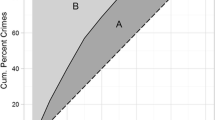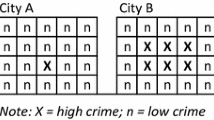Abstract
Objectives
The law of crime concentration states that half of the cumulative crime in a city will occur within approximately 4% of the city’s geography. The law is demonstrated by counting the number of incidents in each of N spatial areas (street segments or grid cells) and then computing a parameter based on the counts, such as a point estimate on the Lorenz curve or the Gini index. Here we show that estimators commonly used in the literature for these statistics are biased when the number of incidents is low (several thousand or less). Our objective is to significantly reduce bias in estimators for the law of crime concentration.
Methods
By modeling crime counts as a negative binomial, we show how to compute an improved estimate of the law of crime concentration at low event counts that significantly reduces bias. In particular, we use the Poisson–Gamma representation of the negative binomial and compute the concentration statistic via integrals for the Lorenz curve and Gini index of the inferred continuous Gamma distribution.
Results
We illustrate the Poisson–Gamma method with synthetic data along with homicide data from Chicago. We show that our estimator significantly reduces bias and is able to recover the true law of crime concentration with only several hundred events.
Conclusions
The Poisson–Gamma method has applications to measuring the concentration of rare events, comparisons of concentration across cities of different sizes, and improving time series estimates of crime concentration.






Similar content being viewed by others
References
Andresen Martin A, Curman Andrea S, Linning Shannon J (2017) The trajectories of crime at places: understanding the patterns of disaggregated crime types. J Quant Criminol 33(3):427–449
Andresen MA, Malleson N (2011) Testing the stability of crime patterns: implications for theory and policy. J Res Crime Delinq 48(1):58–82
Bernasco W, Steenbeek W (2017) More places than crimes: implications for evaluating the law of crime concentration at place. J Quant Criminol 33(3):451–467
Braga AA, Papachristos AV, Hureau DM (2010) The concentration and stability of gun violence at micro places in boston, 1980–2008. J Quant Criminol 26(1):33–53
Braga AA, Papachristos AV, Hureau DM (2014) The effects of hot spots policing on crime: an updated systematic review and meta-analysis. Justice Q 31(4):633–663
Brantingham PJ (2016) Crime diversity. Criminology 54(4):553–586
Brantingham PJ, Brantingham PL (1984) Patterns in crime. Mackmillan, New York
Brantingham PL, Brantingham PJ (1999) A theoretical model of crime hot spot generation. Stud Crime Crime Prev 8(1):7–26
Curiel RP, Bishop S (2016) A measure of the concentration of rare events. Sci Rep 6:32369
Curiel RP, Delmar SC, Bishop SR (2018) Measuring the distribution of crime and its concentration. J Quant Criminol 34(3):775–803
Da Fonseca J, Zaatour R (2014) Hawkes process: Fast calibration, application to trade clustering, and diffusive limit. J Futures Mark 34(6):548–579
Daley DJ, Vere-Jones D (2003) An introduction to the theory of point processes: volume I: Elementary theory and methods. Springer, Berlin
Eck JE, Clarke RV, Guerette RT (2007) Risky facilities: crime concentration in homogeneous sets of establishments and facilities. Crime Prev Stud 21:225
Eck JE, Lee YJ, SooHyun O, Martinez N (2017) Compared to what? estimating the relative concentration of crime at places using systematic and other reviews. Crime Sci 6(1):8
Federal Bureau of Investigation (2016) Crime in the united states. Uniform crime reports online
Giles DEA (2004) Calculating a standard error for the gini coefficient: some further results. Oxf Bull Econ Stat 66(3):425–433
Haberman CP (2017) Overlapping hot spots? Criminol Public Policy 16(2):633–660
Hibdon J, Groff ER (2014) What you find depends on where you look: using emergency medical services call data to target illicit drug use hot spots. J Contemp Crim Justice 30(2):169–185
Hipp JR, Kim Y-A (2017) Measuring crime concentration across cities of varying sizes: complications based on the spatial and temporal scale employed. J Quant Criminol 33(3):595–632
Karlin S (2014) A first course in stochastic processes. Academic Press, Cambridge
Kennedy LW, Caplan JM, Piza E (2011) Risk clusters, hotspots, and spatial intelligence: risk terrain modeling as an algorithm for police resource allocation strategies. J Quantit Criminol 27(3):339–362
Langel M, Tillé Y (2013) Variance estimation of the gini index: revisiting a result several times published. J R Stat Soc: Ser A (Stat Soc) 176(2):521–540
Macbeth E, Ariel B (2017) Place-based statistical versus clinical predictions of crime hot spots and harm locations in Northern Ireland. Justice Q. https://doi.org/10.1080/07418825.2017.1360379
Mohler GO, Short MB, Malinowski S, Johnson M, Tita GE, Bertozzi AL, Jeffrey Brantingham P (2015) Randomized controlled field trials of predictive policing. J Am Stat Assoc 110(512):1399–1411
Mohler GO, Short MB, Brantingham PJ (2017) The concentration dynamics tradeoff in crime hot spotting. Unraveling Crime-Place Connect 22:19–40
Oliveira M, Bastos-Filho C, Menezes R (2017) The scaling of crime concentration in cities. PLoS ONE 12(8):e0183110
Salem ABZ, Mount TD (1974) A convenient descriptive model of income distribution: the gamma density. Econometrica 42(6):1115–1127
Sampson RJ, Byron Groves W (1989) Community structure and crime: testing social-disorganization theory. Am J Sociol 94(4):774–802
Sampson RJ, Raudenbush SW, Earls F (1997) Neighborhoods and violent crime: a multilevel study of collective efficacy. Science 277(5328):918–924
Santitissadeekorn N, Short MB, Lloyd DJB (2018) Sequential data assimilation for 1D self-exciting processes with application to urban crime data. Comput Stat Data Anal 128:163–183
Schlattmann P, Hoehne J, Verba M (2015) Caman: finite mixture models and meta-analysis tools based on ca man 2014: R package version 0.71
Schnell C, Braga AA, Piza EL (2017) The influence of community areas, neighborhood clusters, and street segments on the spatial variability of violent crime in Chicago. J Quant Criminol 33(3):469–496
Sherman LW, Gartin PR, Buerger ME (1989) Hot spots of predatory crime: routine activities and the criminology of place. Criminology 27(1):27–56
Sherman LW, Weisburd D (1995) General deterrent effects of police patrol in crime “hot spots”: a randomized, controlled trial. Justice Q 12(4):625–648
Weisburd D (2015) The law of crime concentration and the criminology of place. Criminology 53(2):133–157
Weisburd D (2018) Hot spots of crime and place-based prevention. Criminol Public Policy 17(1):5–25
Weisburd D, Bruinsma GJN, Bernasco W (2009) Units of analysis in geographic criminology: historical development, critical issues, and open questions. In: Putting crime in its place, Springer, Berlin, pp 3–31
Weisburd D, Bushway S, Lum C, Yang S-M (2004) Trajectories of crime at places: a longitudinal study of street segments in the city of seattle. Criminology 42(2):283–322
Weisburd D, Cave B, Nelson M, White C, Haviland A, Ready J, Lawton B, Sikkema K (2018) Mean streets and mental health: depression and post-traumatic stress disorder at crime hot spots. Am J Commun Psychol 61(3–4):285–295
Weisburd D, Green L (1995) Policing drug hot spots: the jersey city drug market analysis experiment. Justice Q 12(4):711–735
Weisburd D, Groff ER, Yang S-M (2012) The criminology of place: street segments and our understanding of the crime problem. Oxford University Press, Oxford
White C, Weisburd D (2017) A co-responder model for policing mental health problems at crime hot spots: findings from a pilot project. Polic: J Policy Pract 12(2):194–209
Xu K (2003) How has the literature on Gini’s index evolved in the past 80 years? https://ssrn.com/abstract=423200
Zhuang J, Ogata Y, Vere-Jones D (2002) Stochastic declustering of space-time earthquake occurrences. J Am Stat Assoc 97(458):369–380
Acknowledgements
This work was supported in part by NSF Grants SCC-1737585, SES-1343123, ATD-1737996, and ATD-1737925.
Author information
Authors and Affiliations
Corresponding author
Rights and permissions
About this article
Cite this article
Mohler, G., Brantingham, P.J., Carter, J. et al. Reducing Bias in Estimates for the Law of Crime Concentration. J Quant Criminol 35, 747–765 (2019). https://doi.org/10.1007/s10940-019-09404-1
Published:
Issue Date:
DOI: https://doi.org/10.1007/s10940-019-09404-1






